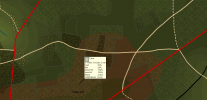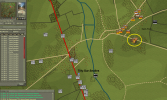Looks great, Bie. Loads of work to do it that way. An easier way would be to rename the fields tile as 'bocage' and really seriously change the field values so that they were roughly similar to forest. That way you don't really have to re-draw very much. For myself this would be very realistic as there isn't really anything that might be thought of as 'clear' in the Normandy countryside that isn't a field. So you could just regard the base layer as fields and the field graphic as that special type of field - the bocage. No need then to draw so many line graphics. They may end up confusing the engine, no, given the grid situation? Some of them are nice - so we really know that the fields they enclose are bocage, but I would just re-name your 'bocage' obstruction to 'large hedge' and then it will all work with you using the method I've stated, no? I'm not just trying to save you work - also conscious of the confusion that arises when you interogate the map for terrain details and there are many overlapping types of terrain. All of your present 'bocage' probably overlaps with something, for example.
That makes sense. I've changed the layers as you suggested. As for the hedges overlapping other layers: most of the time I put the hegdes close to the roads. As far as the engine is concerned it retains the speed that the road provides and it also retains the limited los that comes from the hedges. So for me that is a win-win.
Your example looks beautiful though. If you stick with it, then shouldn't you be filling in the gaps between your bocage lines with 'field' instead of the base layer?
Yeah, I'm filling most of the patches with bocage (former field) layer. Yet some patches I leave open. So there would be just hedges with a base layer in it. This is just to give some variety. As completely plastering the map with bocage would also not be realistic, nor would it make for an enjoyable scenario.

